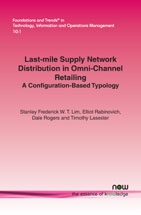Last-mile Supply Network Distribution in Omnichannel Retailing: A Configuration-Based Typology
By Stanley Frederick W. T. Lim, University of Cambridge, UK, wtsfl2@cam.ac.uk | Elliot Rabinovich, Arizona State University, USA, Elliot.Rabinovich@asu.edu | Dale S. Rogers, Arizona State University, USA, Dale.Rogers@asu.edu | Timothy M. Laseter, University of Virginia, USA, LaseterT@Darden.virginia.edu
Abstract
This monograph develops a configuration-based typology describing last-mile supply network (LMSN) distribution configurations in omnichannel retailing. The goal was to integrate relevant terms that have been used disjointedly, with fragmented bodies of theory describing various forms of LMSN. A review of the academic and practice literature was conducted and complemented with secondary observations identifying the key configuration dimensions. Established guidelines for typology and theory building (e.g., Doty and Glick, 1994) were employed in order to develop the typology. The proposed typology comprises four ideal types: Simple LMSN, Hyperlocal LMSN, One-Stop LMSN, and Protean LMSN. The four types are described along the dimensions of: (1) network structure, (2) network flow, (3) relationship governance, and (4) service architecture. Referred to here as the SHOP typology in LMSN, each type is associated with one or more core logistics capabilities elaborated on in a capability profile. The typology identifies useful LMSN evolutionary patterns and enables scholars to develop models and theories based on the four configurations relating their findings to a specific configuration or across them, rather than expanding efforts on separate and unconnected studies. Notwithstanding, it incorporates elements of the omnichannel context which updates the previous “chain-centric” typology developed by Boyer et al. (2005). It also serves as a stepping-stone toward improved insights on what drives, facilitates, and inhibits “fit” potential of LMSN distribution configuration. The research output enhances managers’ understanding of the various forms of LMSN and assists in the identification of possible routes to establish configuration footprints across different LMSNs to support retailers’ omnichannel retailing strategies.
Last-mile Supply Network Distribution in Omnichannel Retailing: A Configuration-Based Typology
Omnichannel retailing (OCR) strategies have recently emerged as a powerful engine of growth in the retail industry. The goal is to provide consumers with a seamless and consistent shopping experience across different channels and devices. Success in implementing OCR strategies depends on sophisticated compromises between fulfilment responsiveness and product variety across different product types, consumer segments, and shopping occasions. Failures in OCR strategies to optimize the trade-offs between responsiveness and variety are rooted in a poor understanding of how OCR strategies should build on last-mile supply network (LMSN) distribution configurations.
Last-mile Supply Network Distribution in Omnichannel Retailing: A Configuration-Based Typology addresses this issue by developing a typology of LMSN distribution configurations in OCR. Typologies are useful for four reasons: (1) they provide a mechanism for incorporating holistic principles of inquiry into organizational research; (2) they explicitly define patterns of constructs that determine dependent variables while enabling researchers to move beyond traditional linear theories; (3) they provide a means to incorporate equifinality; and (4) they establish connections between the findings of various studies.
The existing literature covers a number of last-mile typological systems in the supply chain. However, these typologies do not provide a satisfactory characterization of various forms of LMSN distribution configurations in OCR and their unique structure, product/order and information flow, service architecture, and relational and governance aspects. To address these deficiencies in the literature, this typology updates the linearly “chain-centric” extended supply chain models developed previously and provides a framework that integrates multiple theoretical domains and terminologies that have been used disjointedly to describe the various forms of LMSN distribution configurations in OCR.
After an introduction, Section 2 presents a review of the literature. Section 3 describes the methodology used to identify the different configuration dimensions and provides definitions of the terminologies. Section 4 describes the LMSN configuration-based typology while Section 5 presents LMSN evolution patterns through the discussion of example cases. Section 6 highlights key insights derived from the typology, elaborates on academic implications, and suggests some research extensions. Section 7 discusses the managerial implications and concludes.
